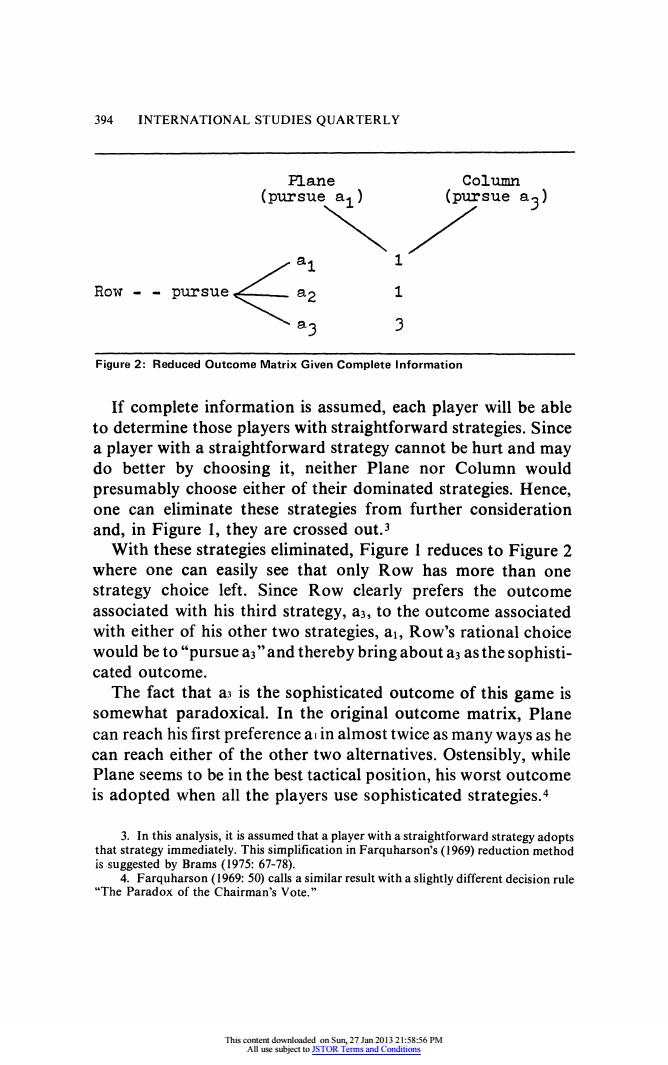正在加载图片...

394 INTERNATIONAL STUDIES QUARTERLY Plane Column (pursue a1) (pursue a3) 61 Row --pursue 82 1 83 3 Figure 2:Reduced Outcome Matrix Given Complete Information If complete information is assumed,each player will be able to determine those players with straightforward strategies.Since a player with a straightforward strategy cannot be hurt and may do better by choosing it,neither Plane nor Column would presumably choose either of their dominated strategies.Hence, one can eliminate these strategies from further consideration and,in Figure 1,they are crossed out.3 With these strategies eliminated,Figure I reduces to Figure 2 where one can easily see that only Row has more than one strategy choice left.Since Row clearly prefers the outcome associated with his third strategy,a3,to the outcome associated with either of his other two strategies,ai,Row's rational choice would be to "pursue a3"and thereby bring about a3 as the sophisti- cated outcome. The fact that a is the sophisticated outcome of this game is somewhat paradoxical.In the original outcome matrix,Plane can reach his first preference a in almost twice as many ways as he can reach either of the other two alternatives.Ostensibly,while Plane seems to be in the best tactical position,his worst outcome is adopted when all the players use sophisticated strategies.4 3.In this analysis,it is assumed that a player with a straightforward strategy adopts that strategy immediately.This simplification in Farquharson's(1969)reduction method is suggested by Brams(1975:67-78). 4.Farquharson(1969:50)calls a similar result with a slightly different decision rule "The Paradox of the Chairman's Vote." 物2226w rms and Conditions394 INTERNATIONAL STUDIES QUARTERLY Plane Column (pursue a,) (pursue a3) al 1 Row - - pursue a2 1 a3 3 Figure 2: Reduced Outcome Matrix Given Complete Information If complete information is assumed, each player will be able to determine those players with straightforward strategies. Since a player with a straightforward strategy cannot be hurt and may do better by choosing it, neither Plane nor Column would presumably choose either of their dominated strategies. Hence, one can eliminate these strategies from further consideration and, in Figure 1, they are crossed out.3 With these strategies eliminated, Figure I reduces to Figure 2 where one can easily see that only Row has more than one strategy choice left. Since Row clearly prefers the outcome associated with his third strategy, a3, to the outcome associated with either of his other two strategies, a,, Row's rational choice would be to "pursue a3" and thereby bring about a3 as the sophisticated outcome. The fact that a3 is the sophisticated outcome of this game is somewhat paradoxical. In the original outcome matrix, Plane can reach his first preference a, in almost twice as many ways as he can reach either of the other two alternatives. Ostensibly, while Plane seems to be in the best tactical position, his worst outcome is adopted when all the players use sophisticated strategies.4 3. In this analysis, it is assumed that a player with a straightforward strategy adopts that strategy immediately. This simplification in Farquharson's (1969) reduction method is suggested by Brams (1975: 67-78). 4. Farquharson (1969: 50) calls a similar result with a slightly different decision rule "The Paradox of the Chairman's Vote." This content downloaded on Sun, 27 Jan 2013 21:58:56 PM All use subject to JSTOR Terms and Conditions